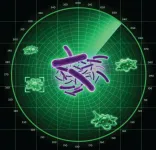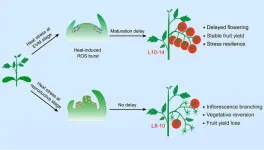(Press-News.org) They say music is the universal language of humankind, but some stars in our galaxy exhibit their own rhythm, offering fresh clues into how they and our galaxy evolved over time.
According to an international team of researchers, including scientists from The Australian National University (ANU) and UNSW Sydney, some stars exhibit fluctuations in their brightness over time, which are caused by continuous ‘starquakes’.
These fluctuations can be translated into frequencies, which can be used to determine a star’s age and other properties such as its mass.
Study lead author Dr Claudia Reyes from ANU imagined stars as musical instruments, each playing a distinct melody.
“Starquakes occur in certain stars, leading to a continuous cycle of brightening and dimming. By carefully observing these tiny fluctuations in brightness, we can listen to a star’s musical rhythm,” Dr Reyes, who completed most of this work during her time at UNSW Sydney, said.
“These fluctuations are like musical notes, similar to the vibrations of a string or the hum of a drum, that can be translated into frequencies. Each frequency tells us more about the star’s size, chemical composition and internal structure.”
Dr Reyes said that each of the stars they studied has a “shell of energy around its core” that helps keep them alive. This region of the star is like a furnace where nuclear reactions take place and elements are formed. These reactions produce very large amounts of energy, and elements produced during these reactions are emitted into the universe.
As a star ages and its mass and internal structure changes – such as when a star evolves into a subgiant or red giant – these so-called furnace regions near their core can become bigger or smaller.
When this happens, a star emits different frequencies, an important discovery that brings scientists a step closer to piecing together the history of our galaxy.
The researchers studied frequencies emitted by stars in a region of our galaxy known as the ‘open cluster M67’. Dr Reyes said the research team was interested in these specific stars because they are like siblings – they were born from the same molecular cloud at the same time and therefore share the same age and chemical composition.
Stars in the M67 cluster also share similar qualities to stars close to Earth, such as our Sun.
“We studied frequencies emitted by stars in this cluster as they evolved into subgiants and red giants – something that had never been fully explored before,” Dr Reyes said.
The scientists discovered that stars in this cluster reach a point in their life where the signature of the frequency they emit temporarily halts once it reaches a certain point, as if the signal were caught in a loop, repeating itself like a broken record, before resuming its progression. Dr Reyes calls this moment the “plateau”.
“Stars have multiple layers, similar to an onion. We discovered that the plateau occurs due to events in a specific layer of the star and at specific frequencies that are influenced by a star’s mass and metallicity,” Dr Reyes said.
“This means we can predict when and at what frequency the plateau will occur during a star’s life cycle, enabling extremely precise age estimates for stars currently in their plateau phase.
“This research helps us better understand how stars evolve and provides a new tool to estimate their age, which is crucial for studying the evolution of our galaxy.”
The research is published in Nature. This work involved scientists from ANU, UNSW Sydney, the University of Sydney, Yale University, the University of Hawaii and Massachusetts Institute of Technology.
Images and other materials available to download here.
END
Melodies of musical ‘starquakes’ shed new light on how our galaxy formed
2025-04-02
ELSE PRESS RELEASES FROM THIS DATE:
Protective radar for bacteria
2025-04-02
Investigation how microorganisms communicate enhances our understanding of the complex ecological interactions that shape our environment – a major focus of the Cluster of Excellence “Balance of the Microverse”. A research team of the Cluster at the Leibniz Institute for Natural Product Research and Infection Biology - Hans Knöll Institute (Leibniz-HKI) and the Friedrich Schiller University, Jena has studied the interaction between amoebae, bacteria, and plants. Researchers from the ...
Increased utilization of overtime and agency nurses and patient safety
2025-04-02
About The Study: The findings of this study suggest that both nurse overtime and nurse agency hours are associated with increased rates of pressure ulcers, a measure that is one of the most sensitive to nursing care. In future research, hospitals could use their own data to track safe thresholds.
Corresponding Author: To contact the corresponding author, Patricia Pittman, PhD, email ppittman@gwu.edu.
To access the embargoed study: Visit our For The Media website at this link https://media.jamanetwork.com/
(doi:10.1001/jamanetworkopen.2025.2875)
Editor’s ...
Spending on glucagon-like peptide-1 receptor agonists among US adults
2025-04-02
About The Study: Spending on glucagon-like peptide-1 receptor agonists (GLP-1 RAs) increased from 2018 to 2023, with the largest growth rates from 2022 to 2023. Although spending for certain GLP-1 RAs increased substantially, spending declined for others. This study estimated that more than $71 billion was spent on GLP-1 RAs and more than $50 billion on a product based on either semaglutide or tirzepatide molecules.
Corresponding Author: To contact the corresponding author, Stavros Tsipas, MA, email stavros.tsipas@ama-assn.org.
To ...
Early-life ozone exposure and asthma and wheeze in children
2025-04-02
About The Study: In this cohort study with relatively low ambient ozone exposure, early-life ozone was associated with asthma and wheeze outcomes at age 4 to 6 and in mixture with other air pollutants but not at age 8 to 9. Regulating and reducing exposure to ambient ozone may help reduce the significant public health burden of asthma among U.S. children.
Corresponding Author: To contact the corresponding author, Logan C. Dearborn, MPH, email dearbl@uw.edu.
To access the embargoed study: Visit our For The Media website at this link https://media.jamanetwork.com/
(doi:10.1001/jamanetworkopen.2025.4121)
Editor’s ...
Early Earth's first crust composition discovery rewrites geological timeline
2025-04-02
Researchers have made a new discovery that changes our understanding of Earth’s early geological history, challenging beliefs about how our continents formed and when plate tectonics began.
A study published in Nature on 2 April reveals that Earth's first crust, formed about 4.5 billion years ago, probably had chemical features remarkably like today’s continental crust.
This suggests the distinctive chemical signature of our continents was established at the very beginning of Earth’s history.
Professor Emeritus Simon ...
Dark diversity reveals global impoverishment of natural vegetation
2025-04-02
A study recently published in Nature indicates that human activities have a negative effect on the biodiversity of wildlife hundreds of kilometres away. A research collaboration led by the University of Tartu assessed the health of ecosystems worldwide, considering both the number of plant species found and the dark diversity – the missing ecologically suitable species.
For the study, over 200 researchers studied plants at nearly 5,500 sites in 119 regions worldwide, including all continents. At each site, they recorded all plant species on 100 m2 and identified the dark diversity – native species that could live there but were absent. ...
Study finds rates of breast and colorectal cancer screening nearly four-fold higher than lung cancer screening among those eligible
2025-04-02
Lung cancer screening has the potential to catch lung cancer early and save lives—but only if people get screened. Although lung cancer screening is recommended in the U.S. for certain individuals with a history of smoking, only 18% of eligible individuals in the U.S. get screened. One suggested explanation has been that those eligible are resistant to receiving preventive healthcare, but a new study published in JAMA and led by researchers at Mass General Brigham indicates otherwise.
Researchers from Mass General Brigham sought to investigate use of other preventive healthcare services among individuals eligible for lung cancer screening. ...
Sound frequencies of stars sing of our galaxy’s past and future
2025-04-02
A new study led by UNSW Sydney researchers into a cluster of stars 2700 light years away reveals their stages of evolution through the ‘sounds’ they make. This discovery will allow scientists to map the history of the Milky Way and other galaxies, accelerating knowledge in the field of astrophysics.
Dr Claudia Reyes is the lead author of the study published today in Nature. While undertaking her PhD at the UNSW School of Physics, she studied 27 stars in a cluster of stars called M67. The stars in ...
Tomato plants delay shoot meristem maturation to achieve heat-stress resilience
2025-04-02
As global temperatures continue to rise, extreme heatwaves pose a significant threat to agricultural productivity. Studies estimate that for every 1°C increase above pre-industrial levels, crop yields decline by approximately 6-8%. The ability of plants to withstand heat stress is therefore critical for ensuring food security, yet the underlying molecular mechanisms have largely remained elusive.
Now, however, a new study led by Prof. XU Cao's team at the Institute of Genetics and Developmental Biology (IGDB) of the Chinese Academy of Sciences sheds light on an adaptive strategy that may ...
KTU researchers explore using soil for heat storage
2025-04-02
When spring arrives and the heating season comes to an end, keeping warm becomes less of an issue. However, scientists remind us that it is not just a seasonal necessity – heat is also a valuable energy resource that can be stored and used when needed most. Researchers at Kaunas University of Technology (KTU) have discovered an innovative solution beneath our feet: using soil as an efficient thermal energy storage system.
KTU professor Dr Tadas Ždankus and his team have been investigating how the ground can serve not only for construction purposes but also as a medium for heat storage. At the ...




